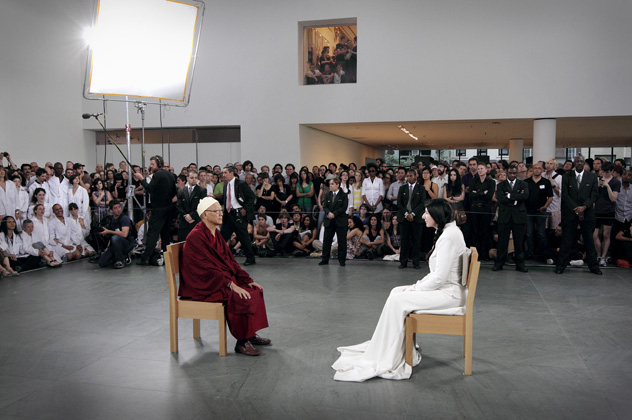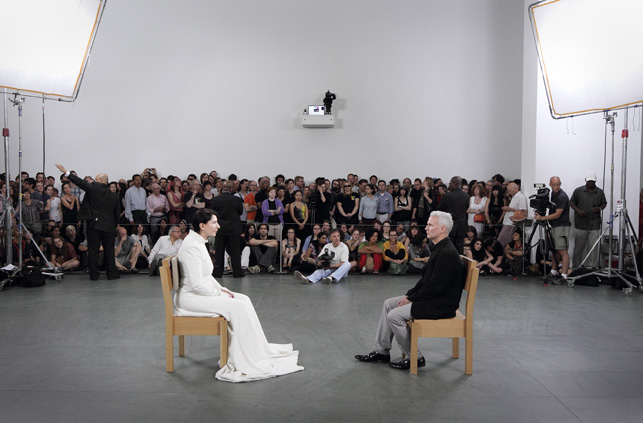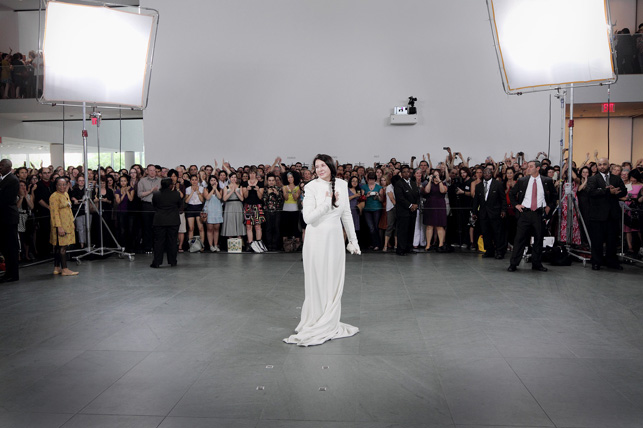What were some surprises you encountered during the performance? What insights did they contribute?
When I conceived this piece I really left it open to what’s going to happen, but the surprises I have are about the participation of the people—how people in New York accepted the piece and started sitting a really long time with me. This was especially interesting because, as we know, the American culture is an extremely materialistic culture and is based on money, and work, and the intensity of moving and living, and going always to the next thing. Here, everything was about stillness and about literally doing nothing and being in the present. So to expect an American to come to the Museum and sit seven hours, and not only sit for a long time but also to come back again and again, and create a community around this piece, this was very surprising. And I think especially the community—how the people actually started meeting each other around the work, how this circulated and how they continue to get into kind of a friendship situation—that was a really new thing to me.

Marina Abramović sits with the second-to-last sitter: Lama Doboom Tulku Rinpoche, a long time friend of the artist and Director of the Tibet House, the cultural center of the Dalai Lama in New Delhi. © 2010 Photograph by Marco Anelli
How did your experience change depending on whether people sat for a short time or a long time?
It was much better if the people sat longer than shorter because there was more time to work with the material, with the energy. When they sit for a short time, it’s kind of a short investment and they can’t get as much out of it. For me, it’s very important that I create the kind of circumstances in the space that when people come into that zone they actually forget about the time. And this really happened—people came and sat with me for forty minutes and they were thinking it was ten minutes, so they lost the sense [of time]. The longest sitting is definitely a more transformative experience for me and for the audience, too.
What do you make of the fact that so many people became emotional?
What is very new about this performance is that we always perceive the audience as a group, but a group consists of many individuals. In this piece I deal with individuals of that group and it’s just a one-to-one relationship. So, when you enter the square of light and you sit on that chair, you’re an individual, and as an individual you are kind of isolated. And you’re in a very interesting situation because you’re observed by the group (the people waiting to sit), you’re observed by me, and you’re observing me—so it’s like triple observation. But then, very soon while you’re having this gaze and looking at me, you start having this invert and you start looking at yourself. So I am just a trigger, I am just a mirror and actually they become aware of their own life, of their own vulnerability, of their own pain, of everything—and that brings the crying. [They are] really crying about their own self, and that is an extremely emotional moment.

Marina Abramović with the final sitter: Klaus Biesenbach, the curator of the exhibition. Photograph © 2010 Marco Anelli
For people who didn’t have the chance to sit with you but observed on the sidelines, what do you think the experience of the piece was from this purely external perspective?
First, there was an enormous amount of young people, which was for me very significant. We are living in this culture that is so isolated—everything is on the computer, and Twitter and blogs—so the people really lost the self a long time ago and they are so desperate to find something else. They invest an enormous amount of time waiting to actually get to sit. The last months it was this phenomenon where people first started [waiting] at six in the morning, then midnight, and the last few days the museum would close and if they didn’t sit they would just go around the block and start sitting until the next day. So, for me, the waiting to sit is a very important part of the piece because it’s not just about being there in the front, it’s about taking that time, and going through the process. To me, the waiting and the sitting itself are actually complementary.
Was there ever a point during the project where you were overwhelmed or wanted to quit?
You know, I never in my entire life quit a performance…except for if I will be hospitalized for any external reasons. Probably because my parents were two national heroes, quitting is not an option. I think if you have in your mind to quit, you are going to quit, but I never had this as an option. To me, my motto is if you say no to me, it’s just the beginning. But it was difficult, extremely difficult. The April month was very, very hard. In April, we had five Fridays, which means ten hours of sitting (editor’s note: the Museum is open from 10:30 a.m. to 8 p.m. on Fridays), and that was crucial because with seven hours the body adopts a rhythm, but the Friday always breaks the rhythm into pieces. It’ll be ten hours and the next day immediately seven hours, so I left the Museum to sleep a little and I’m already [back] in the Museum. That was really the hardest time, because I have lots of physical problems, you know, by being still—my legs, my shoulders, my arms.
But at the same time, I learned so much about my body. I learned that in your body you have so much space and you can actually move inside that. There is space between organs, there is space between bones, there is space between atom and cell, so you can actually start training yourself to breathe a kind of air into that space. And then I understood that the pain is actually not having space, it’s when organs and everything press inside, so by breathing air you can make the pain just disappear. And also [there] is a kind of mental commitment, you can actually concentrate to remove the pain away. These three months were a great exercise for me. By the end of this piece I actually had less pain than in the beginning. It’s interesting how you can solve that problem.
Do you classify your performances as successes or failures? And if so, do you think this performance will have changed you or your future practice?
For me, the performance is really important. I learn from my performances, not my life—because in life I always tend to do what I like and that’s kind of a disaster. But in performance I always put a very high task, which I have to complete, and because of the difficulties, I learn in the process, and I really make tremendous change in my private life. But this piece, I think it’s the most difficult task I’ve ever done. These three months it was a huge commitment mentally and physically, and I believe now that long durational work has absolutely the biggest potential to change you mentally and physically—the performer who performs, and also the audience who take task and give themselves time to be changed with the piece itself. So it works in both ways, not just me but the audience also, because the long durational work has this potential, it’s a kind of life energy extension.
Why did you decide to remove the table mid-performance?
Many years ago I was always talking about future art and I was thinking about this idea of how in the future objects should be removed and it should be just the transmission of energy between [artist] and the public. In the end of April I had the man with a wheelchair and in the middle of this piece I realized that I didn’t even know he had legs because the table is there, I don’t see. So I decided to remove the table and when I removed the table then the piece started having sense to me. I know now that I’m really interested more and more in immaterial art, that removing the table is just this direct connection. And I think that reached the point with the public reaction emotionally the most. I mean, everybody comes there, sits five minutes, and is already in tears, crying. It really removed all the obstacles.
This piece definitely changed me on a very deep level. And also, I realized how unimportant things are that had been important to me, how everything is actually such simplicity. We make this crazy life, and decisions. The first thing I’m thinking is to sell my apartment. I want a small room, because I don’t need all this. It’s really incredible how that works.

Nenhum comentário:
Postar um comentário